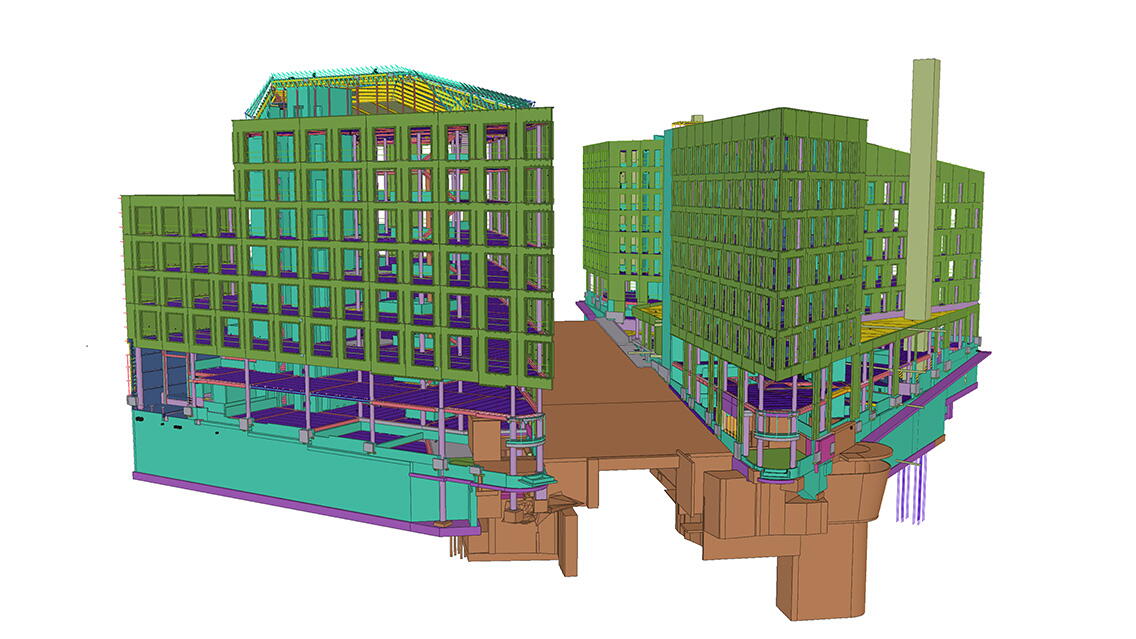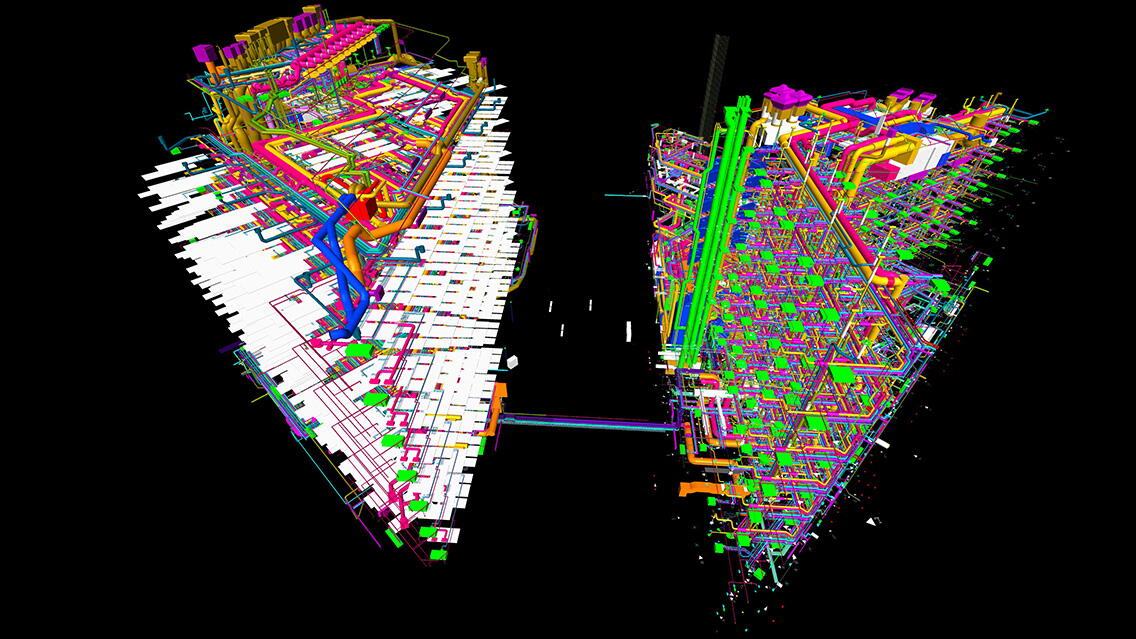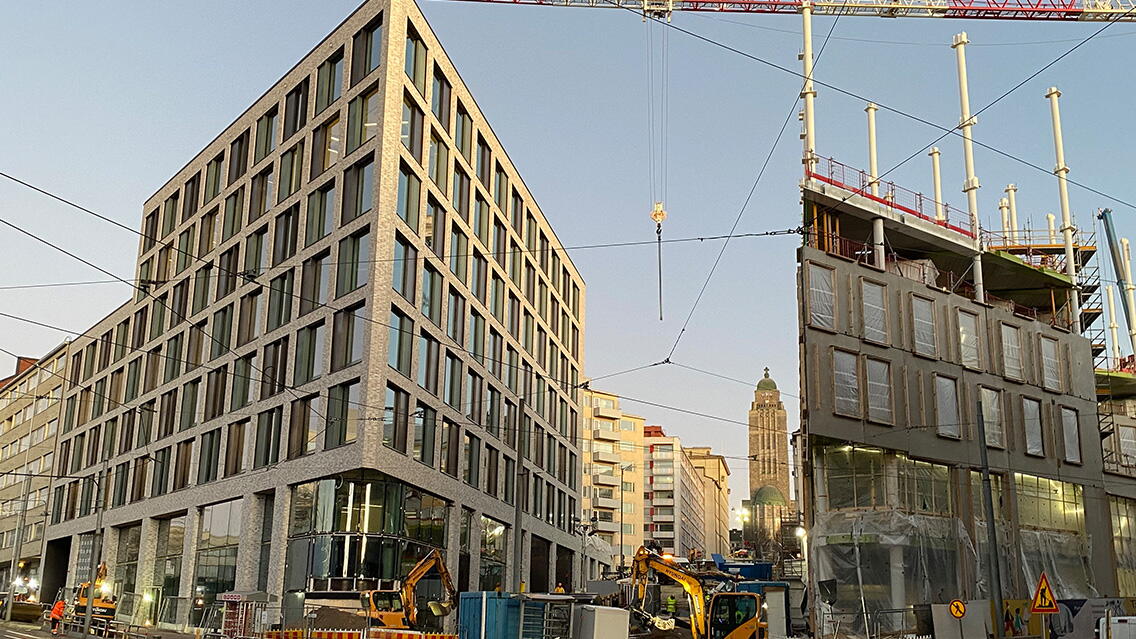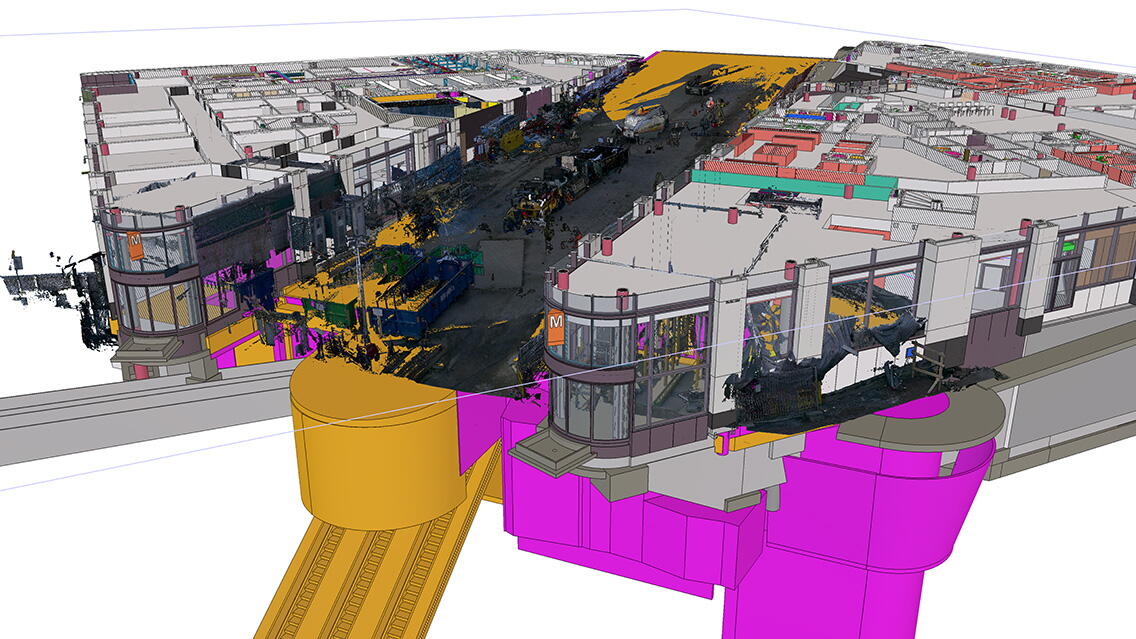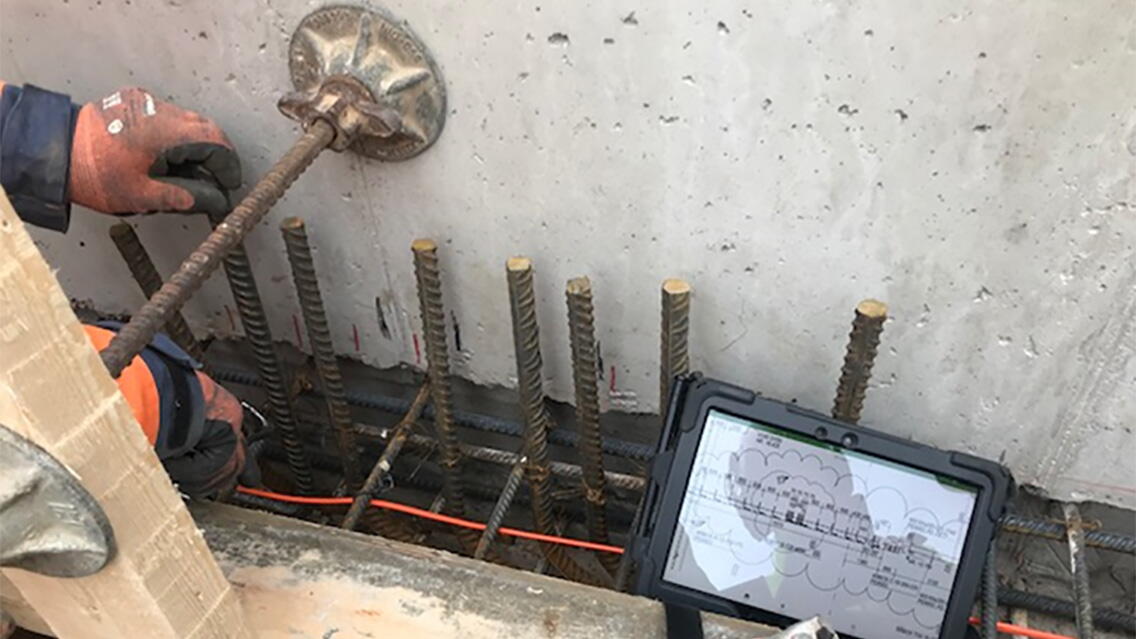The Lyyra project will build a whole new block in the city center on top of the metro station and tunnels. The hybrid project, which includes several different activities, has brought many different levels of detail to the coordination of the plans. The site will serve as offices, retail space, a hotel, and apartments. A particular feature of the project is the coordination with the existing metro facilities, which have a different operator than the other spaces in the building. The project includes 20 200 km2 of building rights floor area, more than 3 100 cavity slabs, around 4 500 m3 of new cast-in-place structures and around 1 600 tonnes of steel structures and fittings in the form of modeled structures.
The site has been designed from the start as a data model
The first drafts consisted of a shell model and spatial zones. The spatial objects were used to extract the extent of the project. In further design, the envelope model was extended into a frame model to support the structural design and, from there, into an Archicad model of the interior, which was further linked to the Twinmotion virtual model. During the site phase, the data model was linked to the Solibri combination model and Dalux software for site use. The data model includes building types and spatial surface data. Door and window lists and diagrams are produced directly from the model, as are sectional and facade drawings. Some spaces, such as hotel rooms and kph elements, are modeled as type modules.
The data models are used to help the designers communicate with each other throughout the project. The combined model of all design disciplines allows each discipline to see immediately the state of completion of the other designs and to advance its own design in a timely manner.
The project uses several different scheduling methods, and data models have been used in various ways to develop the schedules. The methods and scheduling formats used for site schedule management include will production, Last Planner, location-based scheduling, and 4D scheduling. Data models have been extensively used to plan work sequences and calculate scheduling quantities. In addition, the phase scheduling of the frame and envelope has been done as data model based scheduling. Data modeling has been used for quantity surveying and costing and procurement. Computational fluid dynamics of hotel room conditions have also been carried out based on the data models.
The project used the RFEM stability model in a new way by generating graphs for the vertical and horizontal support reactions of Tekla for the determination of the frame noise isolators of the foundations.
Data models play an essential role in the matching and communication between new and old structures
Both buildings in the Lyyra block are located on the metro and metro stations. Structures could not be built on the pressure equalization shaft, so large load transfer structures and suspended platform structures were designed. A full floor-high "jumbo truss", designed in close collaboration between Ramboll and Peiko, will transfer loads to pillars and pilasters at the edges of the service area. Peikko manufactured the truss and was thus responsible for the feasibility of the design and the final product. The alignment was performed using Solibri Office software with BIMcollab linking. Peikko worked in the main structural engineer's model.
Between Lyyra and the neighboring project, the metro station ticket hall renovation, Information was transferred using data models between Lyyra and the neighboring project, the metro station ticket hall renovation. In addition, the surveyor and project designers scanned, as-built, measured, and modeled the old structures on site. As the metro facilities house the technical systems of the metro, the design and implementation had to take into account their functionality during the construction period.
A visualization model developed by an architect was used for the rental operation, and the models were used for a wide range of simulations, including heat load, daylighting, and lighting calculations. Efforts have been made to promote data coordination through cloud-based platforms.
Clashes between building services engineering plans were eliminated from the models through collaboration between designers before designing the hole reservations
The time spent on installing building services components is substantially reduced when all installations can be carried out immediately without the need for dismantling due to incorrect installation. The combination model was used to help contractors plan their work and installation sequence.
Bringing the data models and drawings into the same application and linking them together made a lot possible. For this purpose, the project used the Dalux software. Among other things, the data model-based spatial information can be viewed directly via plane images, both in a browser and on mobile devices.
The design would have been almost impossible without full-scale modeling of the building services, structure, and architecture. Building services installations are sized on-site according to the data model.
During the most intense design phase of the project, weekly design and coordination meetings were held between the Structural /HVAC / Electrical / Sprinkler designers to resolve conflicts and particularly challenging points in advance.
Getting the long prefabricated escalators inside the building and successfully installing them was very challenging. This required the design of a challenging haul solution in close cooperation with the escalator supplier, Kone. Kone provided the haul plan, and Ramboll provided the machine shop drawings for the forklift beams and suspension points.
A paperless construction site by default
Printouts of drawings are only ordered in special cases. Planning the sequence of installation of contractors' work can reduce unnecessary demolition and waste of materials. Site cameras and drone photography have been used for site planning, and monitoring, site worker briefing and site and project visualization.The use of paper plans was significantly reduced.
The site also developed a model for loanable tablet devices, which has been used to demonstrate to contractors the benefits of mobile devices and the usefulness of owning their own devices. In addition, a mobile space for data model review has been provided on-site, giving all workers low-threshold access to the models.
In 2019, the Inclusive Worksite project was launched in Lyra. The aim was to develop solutions to eradicate potential human rights abuses on construction sites and increase equality.
The project aimed to achieve the shortest possible lead time and approached this challenge through a project-wide lean philosophy and will generation. One of the keys to success was the use of intermediate warehouses and the involvement of a logistics contractor in the project.
Numerous sustainability and environmental objectives and measures
The project has applied for Leed Platinum and Well certification. The building services have been designed to improve energy recovery and recycling, and the need for purchased energy is reduced through the use of roof-mounted solar energy collectors. Energy simulations using computer models help to optimize cooling and heating needs on a site-by-site basis. Management can monitor the occupancy rate and adjust the air volumes, temperature, and lighting in low-use areas as necessary.
High targets were set for the demolition of the old office building on the site. The demolition waste had to be recycled as much as possible, and 95% of it was recycled on-site.
The building has a planned lifespan of 100 years, so the easiest possible change of use was taken into account at the design stage. To achieve an even lower carbon footprint, Deltabeam Green beams were chosen for the project instead of Deltabeam beams, which have a carbon footprint of around half that of conventional composite beams.
The client set up a sustainability team for the project, and all buildings were designed in energy class A. An energy recycling system is in place, including heat recovery from wastewater, and low-carbon procurement was emphasized. The site will have zero-emission district heating. The project ensured taxonomy compliance and used Green Deal reporting and biogas for temporary heating.
The office and hotel buildings are connected to a common energy recycling system, where all waste heat, such as the heat load from the electrical rooms and the condensation heat from the refrigeration equipment in the convenience store, as well as the hotel's wastewater treatment, is fed. The payback period of the system is estimated to be around six years.
The roles of the project partners:
Client: Ylva
Project manager and main contractor: Haahtela
Main and architectural design, BIM coordination: Arco Architecture Company Oy
Structural, precast, steel product, HVAC, SPR, energy and moisture control design coordination: Ramboll Finland Oy
Acoustic design: A-Insinöörit Oy
LEED/WELL consultant: Raksystems Engineering Ltd.
GEO and traffic planning: Sitowise Oy
Fire engineering: Jensen Hughes
Vibration consultancy: Suomen Louhintatekniikka
HVAC contractor: Suomen Talotekniikka Oy
Electrical contractor: Paretec Oy
Elevators: KONE Oyj
Logistics contractor: Cramo Finland Oy
Structural contractors: Maru, AKR Oy
Steel frame supplier: Peikko Finland Oy
Precast concrete supplier: Santalan Betoni Oy
BIM coordinator: Byggnadsekonomi Oy

